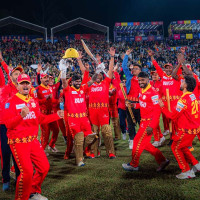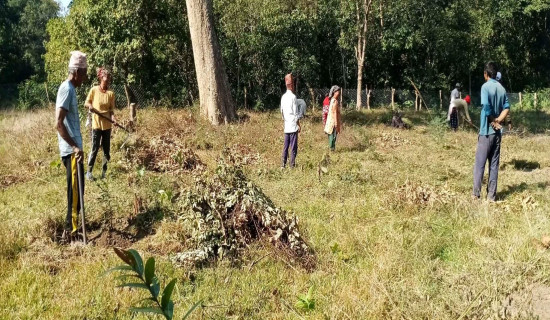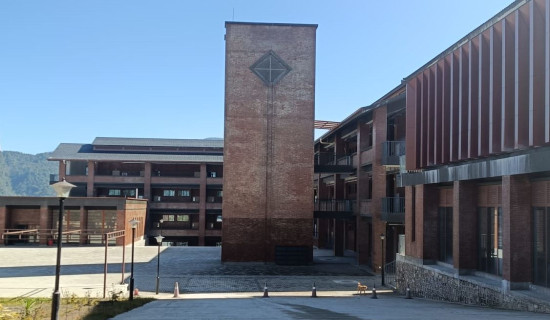- Sunday, 14 December 2025
Dengue cases witness sharp rise
By A Staff Reporter,Kathmandu, Sept. 10: Nepal is witnessing a sharp rise in dengue cases, with 5,287 new infections and four deaths reported in just 53 days, from July 11 and September 2. By September 2, the total number of cases had reached 6,831 across 75 districts.
Tanahun, Kaski, and Parbat have reported the highest number of dengue infections, with 1,149, 764, and 657 cases, respectively.
According to the Epidemiology and Disease Control Division (EDCD) of the Ministry of Health and Population, a significant surge occurred in just 53 days, with the majority of cases recorded since mid-July. Prior to July 11, only 1,544 cases had been reported nationwide.
However, the EDCD had not updated the records of dengue cases on Monday.
Gandaki Province remains the most affected region, with 3,229 cases, followed by Bagmati Province with 1,723 cases. Koshi Province has reported 815 cases, Lumbini 474, Sudurpaschim 379, Madhes 106 and Karnali 105 cases.
The EDCD has identified the 10 districts with the highest number of dengue cases. Kathmandu is the fourth most affected district with 552 dengue cases till September 2, followed by Chitwan with 533 cases, Gorkha 262, Jhapa 168, Makwanpur 125, Lalitpur 119 cases and Syangja with 115 cases.
The data shows that Tanahun reported 33 new dengue cases in just three days (August 30-September 2), marking a 50 per cent decrease compared to the 66 new cases reported during the same period from August 16-19. According to Dr. Gokarna Prasad Dahal, Chief of Vector Control Disease at the EDCD, this is due to the strict preventive measures taken by the local bodies in the district.
Similarly, Kaski reported 119 new dengue cases in three days, followed by Parbat with 70 cases, Kathmandu with 41 cases, and Chitwan with 16 new cases during the same period.
Meanwhile, the Public Health Office, Kathmandu, under the Ministry of Health, Bagmati Province, stated that a total of 563 dengue cases occurred in Kathmandu during the current fiscal year.
According to Prabina Karmacharya, Public Health Officer at the Public Health Office, 563 cases of dengue fever were recorded between July 16 and September 8.
Of these, only 157 cases were reported in the Nepali month of Shrawan, while 406 cases were recorded in the first 23 days of Bhadra.
Karmacharya also noted that Kathmandu Metropolitan City and Tokha Municipality have reported the highest number of dengue cases in the district.
According to Karmacharya, dengue infections typically peak between the Nepali months of Ashad and Ashwin, with cases gradually declining after Kartik.
In 2022, Nepal witnessed a large dengue outbreak with the highest number of cases reported in the Kathmandu valley, when 88 people lost their lives and 54,784 were infected.
Though Kathmandu has not seen a massive outbreak this year, health experts have warned of a potential risk of another outbreak due to a failure to take lesson from the past experience.
As the EDCD has already listed Kathmandu as top fourth district reporting dengue fever cases, Dr. Sher Bahadur Pun, a virologist at Sukraraj Tropical and Infectious Disease Hospital, has warned that the risks posed by repeat dengue fever infections are much greater than those posed by the initial illness.
Reinfection of dengue can cause serious illness, often requiring intensive care and may prove fatal if not diagnosed and treated promptly, he added.
“There are total four serotypes of dengue fever virus (DENV-1, DENV-2, DENV-3 and DENV-4). The body is only able to build immunity to the strain it has previously been exposed to. That means one person is prone to contracting all four strains of the virus throughout their life,” he added. He said that recurrence of dengue infection with separate strain of dengue virus can have serious clinical consequences and can be fatal if not treated promptly.
Dr. Pun further said that dengue patients may exhibit symptoms such as high fever, headaches, severe eye ache, and joint pain.
According to him, dengue is majorly classified into mild dengue fever, dengue hemorrhagic fever and dengue shock syndrome.
“The mild dengue fever causes a high fever and flu-like symptoms, which can be treated at home whereas the severe form of dengue fever, also called dengue hemorrhagic fever, can cause serious bleeding, a sudden drop in blood pressure, shock and eventual death.” In such cases, the patients need immediate treatment, he added.
The mosquito-borne disease is transmitted by Aedes-aegypti and Aedes alobopictus mosquitoes. The mosquitoes of the species are active in the morning and evening time and breed in clean water pools.
Health experts have advised people to keep their surroundings clean and ensure that water does not stagnate in any object.

.jpg)














